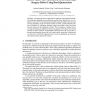Free Online Productivity Tools
i2Speak
i2Symbol
i2OCR
iTex2Img
iWeb2Print
iWeb2Shot
i2Type
iPdf2Split
iPdf2Merge
i2Bopomofo
i2Arabic
i2Style
i2Image
i2PDF
iLatex2Rtf
Sci2ools
DAGM
2003
Springer
2003
Springer
Robust Hand-Eye Calibration of an Endoscopic Surgery Robot Using Dual Quaternions
This paper presents an approach for applying a dual quaternion hand– eye calibration algorithm on an endoscopic surgery robot. Special focus is on robustness, since the error of position and orientation data provided by the robot can be large depending on the movement actually executed. Another inherent problem to all hand–eye calibration methods is that non–parallel rotation axes must be used; otherwise, the calibration will fail. Thus we propose a method for increasing the numerical stability by selecting an optimal set of relative movements from the recorded sequence. Experimental evaluation shows the error in the estimated transformation when using well–suited and ill–suited data. Additionally, we show how a RANSAC approach can be used for eliminating the erroneous robot data from the selected movements.
| Added | 06 Jul 2010 |
| Updated | 06 Jul 2010 |
| Type | Conference |
| Year | 2003 |
| Where | DAGM |
| Authors | Jochen Schmidt, Florian Vogt, Heinrich Niemann |
Comments (0)

